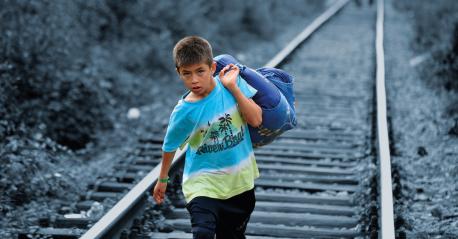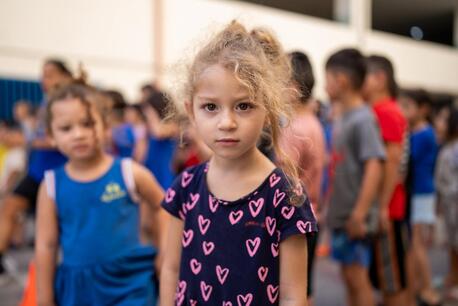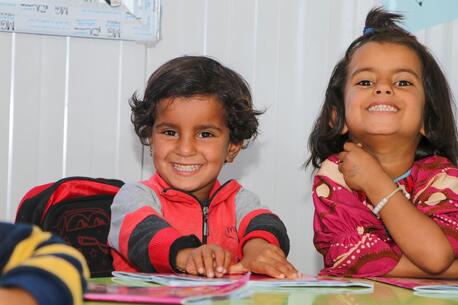
Refugee Relief Guide: How To Help Refugees in 2019
UNICEF is heavily involved in assisting refugees as part of its longstanding commitment to helping vulnerable children all around the world. Here's a guide to UNICEF's work for refugees — and how you can help.
Across the globe, nearly 50 million children are on the move, uprooted by war, natural disasters and poverty, driven from their homes and forced to make difficult and dangerous journeys abroad. Millions of these children are out of school and don't know when they might return.
Saving and protecting migrant, refugee and internally-displaced children is a big part of UNICEF's mission. UNICEF works with local governments and other partners to provide essentials like food, water and medicine, and longer-term services and support in health care, education and other areas that are critical for kids to survive and thrive.

Tawaseef, 5 (left), and Sita, 4, Syrian refugees living with their families in informal tent settlements in Jordan, wear warm hats, scarves, jackets and boots provided by UNICEF. Every year UNICEF distributes winter clothing, blankets and other supplies to help vulnerable children brace against snow storms and freezing temperatures. © UNICEF/UN0274601/Herwig
Here's a look at three major humanitarian deployments focused on refugees.
How UNICEF is helping refugees
- Syrian refugees: The Syrian refugee crisis that began in 2011 remains the largest displacement crisis in the world, with over 5.6 refugees living in Egypt, Iraq, Jordan, Lebanon and Turkey — including 2.5 million children. UNICEF has Syrian refugee assistance programs in all five countries — in health, nutrition and education — and works to help strengthen local support systems and mitigate the economic impact in areas that have struggled to absorb the influx. UNICEF also has a major humanitarian deployment inside Syria to help displaced children who continue to struggle to stay healthy and safe and whose futures remain at risk.
Rohingya refugees: Since the Rohingya refugee crisis began in August 2017, UNICEF has been on the ground, working with partners in refugee settlements in Bangladesh to deliver medicine and clean water, improve sanitation and create child-friendly spaces where kids can learn and play. As of February 2019, there were 155,000 children ages 4-14 benefiting from UNICEF-supported learning programs. UNICEF is also providing education support to children from the host community of Cox's Bazar, one of the Bangladesh's poorest districts.
Refugees from South Sudan play volleyball at a UNICEF Child-Friendly Space in Uganda's Bidi Bidi settlement. UNICEF supports sport and other recreational programs as one way to help kids recover from trauma. © UNICEF/UN068527/Oatway
- Refugees from South Sudan: Years of violence, famine and poverty have forced the displacement of more than 4 million people from South Sudan, including 2.4 million children. UNICEF is reaching hundreds of thousands of these children, who are living in settlements inside the country and in neighboring countries Uganda and Kenya. At the Kakuma Refugee Camp in northwest Kenya, UNICEF focuses on providing children with early childhood education and counseling, immunizations and nutrition, safe water and sanitation. Similiar programs are ongoing at the Bidi Bidi settlement in Uganda's West Nile region, where UNICEF has also teamed up with Lego to launch creative learning program for pre-schoolers.
UNICEF relies on donors and other supporters to help fund these and other programs assisting refugee children worldwide. But there are other ways supporters can help.
How you can help refugees
- Volunteer: Volunteering for UNICEF in the field requires applying through the United Nations Volunteer (UNV) program. Local volunteer opportunities can be found by reaching out to the UNICEF Unite network, or joining or starting a UNICEF Club.
- Speak Up: Write or call your elected representatives and urge them support policies that protect the rights of all children everywhere, including migrant and refugee children. Become a "UNICEF Uniter" and join other front-line advocates here in the United States who are speaking out on behalf of children around the world, working to amplify their voices and effect change here and abroad. Learn more about how you can get active as an advocate for UNICEF in your community.
- Donate: Making a donation to UNICEF helps maintain UNICEF operations on the ground and ensure that UNICEF remains responsive to needs as they arise. Making a monthly donation keeps the support flowing.
You can also organize your own fundraiser — many supporters have launched their own fundraisers online or through social media to support UNICEF's work. UNICEF USA's Facebook page is a great place to start. Not on Facebook? There are other peer-to-peer fundraising platforms to check out. For inspiration go to the UNICEF USA Crowdrise page to see how easy it is to start raising money for children in need. - Medicine: With donor support, UNICEF and partners are able to provide medicine and other critical health care support and services to child refugees and their families. Learn more about UNICEF's strategic priorities related to health in emergencies.
- Legal: The International Refugee Assistance Project helps refugees and displaced people navigate pathways to safety through free direct legal representation, advocacy and litigation. Like UNICEF, the IRAP relies on donor support to provide services to people in need.
Other groups to consider supporting: - The International Rescue Committee, one of the nine NGOs working to help refugees integrate into their new communities and become economically self-sufficient; and
- The United Nations High Commissioner for Refugees, or UN Refugee Agency (UNHCR), which works closely with U.S. government and non-governmental agencies to manage refugee resettlement in the U.S., among many other activities. There are currently nine NGOs that assist with resettlement, with over 350 local affiliates all across the country.

UNICEF Executive Director Henrietta H. Fore visits with Rohingya refugee children outside a learning center in the Kutupalong-Balukhali camp in Cox's Bazar, Bangladesh. © UNICEF/UN0284208/LeMoyne
Learn more about UNICEF's humanitarian action for refugee children and others impacted by emergencies.
Help UNICEF continue to provide emergency assistance and long-term support and protection to child refugees around the world. Every contribution counts.
Top photo: A young boy fleeing Syria makes his way into Serbia. ©UNICEF/UN063127Georgiev
HOW TO HELP
There are many ways to make a difference
War, famine, poverty, natural disasters — threats to the world's children keep coming. But UNICEF won't stop working to keep children healthy and safe.
UNICEF works in over 190 countries and territories — more places than any other children's organization. UNICEF has the world's largest humanitarian warehouse and, when disaster strikes, can get supplies almost anywhere within 72 hours. Constantly innovating, always advocating for a better world for children, UNICEF works to ensure that every child can grow up healthy, educated, protected and respected.
Would you like to help give all children the opportunity to reach their full potential? There are many ways to get involved.





